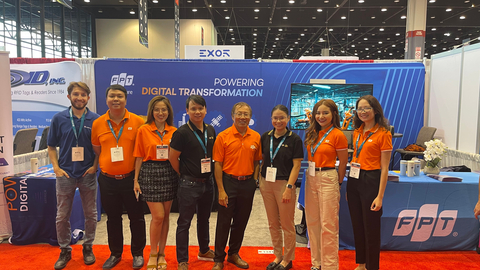With the rise of data-centric MLOps, leading IT companies are taking this approach to build better solutions for real-time inspection in manufacturing. An interview with FPT Software’s Chief AI Officer, Dr. Phong Nguyen, explored the potential of new technologies.
This press release features multimedia. View the full release here: https://www.businesswire.com/news/home/20221106005111/en/

Dr Phong Nguyen (fourth from left) with FPT Software team at Hannover Messe – the largest industrial machinery and manufacturing technology fair, Sep 2022. (Photo: Business Wire)
Artificial Intelligence (AI) applications are considered the next step in the revolution of manufacturing. In a report just released on November 3rd, ResearchAndMarkets.com calculated that the value of AI in Manufacturing is 2.3 billion USD in 2022 and is anticipated to grow to 16.3 billion USD by 2027; growing at a CAGR of 47.9% from 2022 to 2027.
In manufacturing processes, the spotlight is turning to AI in quality inspection as technology and devices improve greatly. Along with high-resolution cameras to discover minuscule defects, manufacturers can choose to apply the new data-centric AI approach, which is proving to be a lot more efficient than rule-based inspection. For example, rule-based inspections require human experts to define a large number of rules and to spend a great deal of time maintaining and adding rules. An AI approach uses machine learning to teach machines to recognise defective features effortlessly from examples.
Pushed forward by Landing AI’s Founder & CEO Dr Andrew Ng, data-centric focused on optimising quality data to refine and shorten the time needed to train AI, instead of spending time, computing resources and efforts on improving state-of-the art models.
One advantage of data-centric AI is that it can increase accuracy by the ability to find new defects based on data learnt. To Chief AI Officer of FPT Software, Dr Phong Nguyen, it also considerably shortens the time it takes to train AI. According to LandingAI in one particular case, LandingLens – the data-centric AI platform specialising in visual inspection – took only 6 minutes to train and bring AI into use, while rule-based machines needed more than 6 months.
“The platform opens a pathway to apply data-centric AI solutions in factory quality inspection, as visual is the most common approach for inspection. The data-centric approach can not only be applied to visual AI, but also to sound and IoTsensor inspection as well,” Dr Phong said.
Earlier this year, FPT Software shook hands with Landing AI in a strategic collaboration to distribute LandingLens to over 1,000 clients of the IT company, focusing on the manufacturing industry. The collaboration means that while LandingAI uses the collective data from real-life problems to improve their platform, FPT Software delivers a full package of end-to-end AI solutions to their clients.
“With experience in vertical industries and technical know-how, our role is to assess each operation system, create algorithms based on the particular problems the client meets, collect and optimise data to train the AI model, and then deploy that model into the factory,” Dr Phong said. “This way, we can help our partner to develop and refine their platform, as well as bring a comprehensive solution to our clients,” he concluded.
In addition to LandingLens, FPT Software is also developing two additional data-centric solutions for sound and IoTsensor inspection, making a complete solution package for their clientele. These AI solutions are trained based on data which the company has collected throughout the years, as they improve their models to solve various issues experienced by factories.
“With the support of our clients, we can collect extremely valuable data in manufacturing for research, and train AI to learn from real-life problems and provide solutions,” Dr Phong said.
In addition to manufacturing, data-centric AI can be used in many more ways within a company. According to Dr Phong, FPT Software has been using this approach to improve employee happiness, increase productivity via Natural language code summarization for people who don’t know how to code to be able to understand, and even to predict the time series to optimise supply for their supply chain.
“In a short time, the approach has been applied successfully in multiple ways. It can give a company a lot more insights and create long-term results,” Dr Phong concluded.
View source version on businesswire.com: https://www.businesswire.com/news/home/20221106005111/en/
